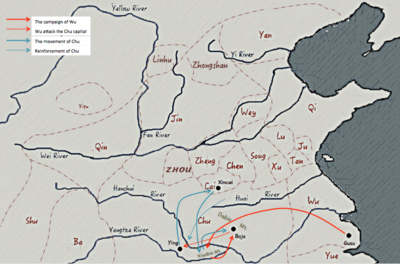Sun Tzu facts for kids
Quick facts for kids
Sun Tzu
|
|||||||||||||||||||||||||||||||||||||||||||||
|---|---|---|---|---|---|---|---|---|---|---|---|---|---|---|---|---|---|---|---|---|---|---|---|---|---|---|---|---|---|---|---|---|---|---|---|---|---|---|---|---|---|---|---|---|---|

Qing-era drawing of Sun Tzu
|
|||||||||||||||||||||||||||||||||||||||||||||
| Native name |
孫子
|
||||||||||||||||||||||||||||||||||||||||||||
| Born | Sun Wu 544 BC (traditional) Qi or Wu |
||||||||||||||||||||||||||||||||||||||||||||
| Died | 496 BC (traditional; aged 47–48) Gusu, Wu State |
||||||||||||||||||||||||||||||||||||||||||||
| Pen name | Sun Tzu | ||||||||||||||||||||||||||||||||||||||||||||
| Occupation | Military general, strategist, philosopher, writer | ||||||||||||||||||||||||||||||||||||||||||||
| Language | Chinese | ||||||||||||||||||||||||||||||||||||||||||||
| Period | Spring and Autumn | ||||||||||||||||||||||||||||||||||||||||||||
| Subject | Military strategy | ||||||||||||||||||||||||||||||||||||||||||||
| Notable works | The Art of War | ||||||||||||||||||||||||||||||||||||||||||||
| Chinese name | |||||||||||||||||||||||||||||||||||||||||||||
| Traditional Chinese | 孫子 | ||||||||||||||||||||||||||||||||||||||||||||
| Simplified Chinese | 孙子 | ||||||||||||||||||||||||||||||||||||||||||||
| Wade–Giles | Sun¹ Tzŭ³ | ||||||||||||||||||||||||||||||||||||||||||||
| Hanyu Pinyin | Sūnzǐ | ||||||||||||||||||||||||||||||||||||||||||||
| Literal meaning | "Master Sun" | ||||||||||||||||||||||||||||||||||||||||||||
|
|||||||||||||||||||||||||||||||||||||||||||||
| Sun Wu | |||||||||||||||||||||||||||||||||||||||||||||
| Traditional Chinese | 孫武 | ||||||||||||||||||||||||||||||||||||||||||||
| Simplified Chinese | 孙武 | ||||||||||||||||||||||||||||||||||||||||||||
| Wade–Giles | Sun¹ Wu³ | ||||||||||||||||||||||||||||||||||||||||||||
| Hanyu Pinyin | Sūn Wǔ | ||||||||||||||||||||||||||||||||||||||||||||
|
|||||||||||||||||||||||||||||||||||||||||||||
| Changqing | |||||||||||||||||||||||||||||||||||||||||||||
| Traditional Chinese | 長卿 | ||||||||||||||||||||||||||||||||||||||||||||
| Simplified Chinese | 长卿 | ||||||||||||||||||||||||||||||||||||||||||||
| Wade–Giles | Ch'ang²-chʻing¹ | ||||||||||||||||||||||||||||||||||||||||||||
| Hanyu Pinyin | Chángqīng | ||||||||||||||||||||||||||||||||||||||||||||
|
|||||||||||||||||||||||||||||||||||||||||||||
| Vietnamese name | |||||||||||||||||||||||||||||||||||||||||||||
| Vietnamese | Tôn Vũ Tôn Tử |
||||||||||||||||||||||||||||||||||||||||||||
| Hán-Nôm | 孫武 孫子 |
||||||||||||||||||||||||||||||||||||||||||||
| Korean name | |||||||||||||||||||||||||||||||||||||||||||||
| Hangul | 손무 손자 |
||||||||||||||||||||||||||||||||||||||||||||
| Hanja | 孫武 孫子 |
||||||||||||||||||||||||||||||||||||||||||||
|
|||||||||||||||||||||||||||||||||||||||||||||
| Japanese name | |||||||||||||||||||||||||||||||||||||||||||||
| Kanji | 孫武 孫子 |
||||||||||||||||||||||||||||||||||||||||||||
| Hiragana | そんぶ そんし |
||||||||||||||||||||||||||||||||||||||||||||
|
|||||||||||||||||||||||||||||||||||||||||||||
Sun Tzu (pronounced "soon-dzoo") was a famous Chinese military general, thinker, and writer. He lived a very long time ago, during a period in China called the Eastern Zhou period (771 to 256 BCE).
Many people believe Sun Tzu wrote The Art of War. This book is about military strategy and has been very important. It has influenced how people think about war and life in both Western and East Asian cultures.
In China and East Asia, Sun Tzu is seen as a legendary hero and military genius. His real name was Sun Wu. The name Sun Tzu is an honorific, which is like a respectful title. It means "Master Sun".
It's not completely certain if Sun Tzu was a real person or if some stories about him are legends. However, his ideas have had a huge impact. The Art of War became popular around the world in the 1900s. Today, its ideas are used in many areas beyond war, like business, sports, and politics.
Contents
Sun Tzu's Life and Times
Ancient writings disagree about where Sun Tzu was born. Some say he was born in a state called Qi. Others say he was from Wu.
Most sources agree that Sun Tzu was a general and strategist. He served King Helü of Wu around 512 BCE. His successful battles are said to have inspired him to write The Art of War.
His book became very popular during the Warring States period. This was a time of constant fighting among seven ancient Chinese states. These states were Zhao, Qi, Qin, Chu, Han, Wei, and Yan. They all wanted to control the rich lands of Eastern China.
A Famous Story About Sun Tzu
One well-known story shows Sun Tzu's strictness as a leader. The King of Wu wanted to test Sun Tzu's skills. He asked Sun Tzu to train 180 of his concubines (women who lived in the king's palace) to be soldiers.
Sun Tzu split them into two groups. He made the two concubines most liked by the king the commanders. When Sun Tzu first told them to face right, they just giggled. Sun Tzu said that a general must make sure soldiers understand commands.
He gave the command again, and they giggled once more. Sun Tzu then ordered the execution of the two favorite concubines. The king protested, but Sun Tzu explained that if soldiers understand but don't obey, it's the officers' fault. He also said that once a general is in charge, they must complete their mission, even if the king disagrees.
After the two concubines were executed, new officers were chosen. After that, both groups of women performed their drills perfectly. They now understood the serious consequences of not obeying.
Historians like Sima Qian claimed Sun Tzu proved his ideas worked in battles. For example, he was said to be successful at the Battle of Boju. However, an older historical text, the Zuozhuan, describes the Battle of Boju in detail but doesn't mention Sun Tzu at all. This makes some scholars wonder about his exact role.
Was Sun Tzu a Real Person?

Around the 1100s AD, some Chinese scholars started to question if Sun Tzu really existed. This was mainly because he isn't mentioned in the Zuo zhuan. This book lists most important people from the Spring and Autumn period.
The name "Sun Wu" doesn't appear in any texts before the Records of the Grand Historian. Some think it might have been a made-up name meaning "the fugitive warrior." The only battle linked to Sun Tzu, the Battle of Boju, has no record of him fighting in it.
Some experts believe The Art of War was written by different authors. They think it was a collection of ideas from various military thinkers. However, others argue that Sun Tzu likely did exist. They believe he was a general who wrote the main parts of the book. His teachings might have been passed down and added to by his family or students over time.
In 1972, ancient texts written on bamboo slips were found. These included The Art of War. This discovery helped scholars learn more about when the book was written. It also showed that the book was mostly in its current form by the early Han dynasty.
The Art of War Book
The Art of War is a famous book about how to manage conflicts and win battles. It is seen as a masterpiece on strategy. Generals and thinkers around the world have often used its ideas.
There are different ideas about when the book was finished and who wrote it. But the discovery of ancient bamboo slips shows that The Art of War was largely complete by the early Han dynasty. This means it's very old!
Of the military books written before China was unified, six major works survived. Later, during the Song dynasty, these six books were put together with another text. This collection was called the Seven Military Classics. The Art of War was a key part of this collection. It became a basic text for military theory in China. People had to read it to pass tests for military jobs in the empire.
The Art of War uses language that might seem unusual to Western readers. For example, it says a leader must be "serene and inscrutable." This means calm and mysterious. These ideas make more sense when you understand them through Taoist philosophy. Sun Tzu saw the best general as an enlightened Taoist master. Because of this, The Art of War is considered a great example of Taoist strategy.
The book is also popular with political leaders and people in business management. Even though it's called The Art of War, it talks about strategy in a wide way. It covers how to manage public affairs and plan. It discusses battle theories but also says that diplomacy and good relationships with other nations are important for a country to be strong.
In 1972, construction workers in Shandong accidentally found the Yinqueshan Han Tombs. Inside, scholars found a collection of ancient texts on bamboo slips. These included The Art of War and another book called Sun Bin's Military Methods. This second book was written by a descendant of Sun Tzu but had been lost for a long time. Finding these texts was very important for understanding ancient Chinese military ideas.
Sun Tzu's Lasting Influence
The Art of War has influenced many important people throughout history. The Chinese historian Sima Qian said that China's first emperor, Qin Shi Huang, found the book very helpful. He used its ideas to end the time of the Warring States and unify China.
In the 20th century, the Chinese Communist leader Mao Zedong said The Art of War helped him win in 1949. The book greatly influenced Mao's ideas about guerrilla warfare. These ideas then influenced other communist groups around the world.
The Art of War arrived in Japan around 760 AD. It quickly became popular among Japanese generals. It influenced leaders like Oda Nobunaga, Toyotomi Hideyoshi, and Tokugawa Ieyasu. These leaders helped unify Japan in the early modern era. Japanese samurai respected those who mastered its teachings.
Ho Chi Minh, a Vietnamese leader, translated the book for his officers. His general, Võ Nguyên Giáp, also studied Sun Tzu's ideas. Giáp used these strategies to win against the French and challenge American forces in Vietnam.
American military leaders became interested in Sun Tzu during conflicts in Asia. The U.S. Army now requires units to have libraries for officers to study military history. The Art of War is listed as a key book to have. The Marine Corps also includes it in its reading program. During the Gulf War in the 1990s, Generals Norman Schwarzkopf Jr. and Colin Powell used Sun Tzu's ideas. These included using deception, speed, and attacking enemy weak points.
In the 1987 movie Wall Street, the character Gordon Gekko often quotes The Art of War. He uses its principles for his aggressive trading strategies.
The ideas of Daoism are a big part of The Art of War. According to Steven C. Combs, warfare in the book is like a metaphor for communication. He says both are based on philosophy. Daoist ideas in The Art of War are described as "peaceful and passive." They favor silence over speaking too much. This approach is about avoiding conflict and being spiritual.
Mark McNeilly writes that understanding Sun Tzu is important for understanding China today. Modern Chinese scholars use historical lessons from The Art of War to develop their strategies. They see a direct link between their current challenges and those in Sun Tzu's time. Sun Tzu's teachings are still highly valued and used by Chinese leaders.
In 2008, a Chinese TV producer made a 40-episode historical drama series. It was called Bing Sheng and was about Sun Tzu's life.
The video game Age of Empires II: Definitive Edition has challenge missions based on Sun Tzu's The Art of War. These missions teach players military tactics.
Images for kids
See also
 In Spanish: Sun Tzu para niños
In Spanish: Sun Tzu para niños





